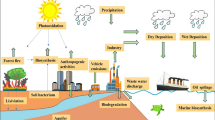Summary
A bacterium isolated from an oil spillage sample and identified asPseudomonas aeruginosa degraded hexadecane and heptadecane by 47% and 58% with 9% and 12% of total carbon from the respective substrates being liberated as CO2. With octadecane and nonadecane as substrates, 73% and 60% were biodegraded while 27% and 25% of total carbon was evolved as CO2, respectively. Production of biosurfactant by this bacterium was studied using hexadecane 5% (v/v) as substrate. The surface tension of spent culture medium, as well as the supernatant, was 30 mN/m compared to 71 mN/m for water. When the supernatant was mixed with hexadecane (1∶5, v/v) a stable emulsion was formed which deteriorated only by 10% after one month.
Résumé
Une bactérie, isolée d'un échantillon d'hydrocarbures épandus, et identifiée commePseudomonas aeruginosa, dégrade l'hexaet l'heptadécane à raison respective de 47 et de 58% du carbone total avec 9 et 12% des substrats respectifs libérés sous la forme de CO2. Avec l'octa- et le nonadécane comme substrats, la biodégradation atteint respectivement 73 et 60% avec 27 et 25% du carbone total transformé en CO2. On a étudié la production de biosurfactant par cette bactérie en utilisant l'hexadécane à 5% (v/v) comme substrat. La tension superficielle de la liqueur mixte, comme celle de son surnageant atteint 30 mN/m par comparaison à 71 mN/m pour l'eau. Lorsque le surnageant est mélangé à l'hexadécane (1∶5, v/v), on forme une émulsion stable qui ne se détériore que de 10% au bout d'un mois.
Similar content being viewed by others
References
Atlas, R. M. &Bartha, R. 1972 Degradation and mineralization of petroleum by two bacteria isolated from coastal water.Biotechnology and Bioengineering 14, 297–308.
Buchanan, R. E. &Gibbons, N. E. 1974Bergey's Manual of Determinative Bacteriology, 8th edn. Baltimore: Williams & Wilkins.
Bushnell, L. D. &Haas, H. F. 1941 The utilization of certain hydrocarbons by microorganisms.Journal of Bacteriology 41, 653–673.
Cooper, D. G. 1986 Biosurfactants.Microbiological Sciences 3, 145–149.
Cooper, D. G. &Goldenberg, B. G. 1987 Surface-active agents from twoBacillus species.Applied and Environmental Microbiology 53, 224–229.
Gutnick, D. L. &Rosenberg, E. 1977 Oil tankers and pollution: a microbiological approach.Annual Review of Microbiology 31, 379–396.
Muller-Hurtig, R., Matulovic, U., Feige, I. &Wagner, F. 1987 Comparison of the formation of rhamnolipids with free and immobilized cells ofPseudomonas species DSM 2874 with glycerol as C-substrate. InProceedings of 4th European Congress on Biotechnology, eds. Neijssel, O. M., Van der Meer, R. R. & Luyben, K. Ch. A. M., Vol. 2, pp. 257–260. Amsterdam: Elsevier.
Rapp, R., Bock, H., Wray, V. &Wagner, F. 1979 Formation, isolation and characterization of trehalose dicorynomycolates fromRhodococcus erythropolis, grown on n-alkanes.Journal of General Microbiology 115, 491–503.
Reiling, H. E., Thanei-Wyss, U., Guerra-Santos, L. H., Hirt, R., Kappeli, O. &Fiechter, A. 1986 Pilot plant production of rhamnolipids biosurfactant byPseudomonas aeruginosa.Applied and Environmental Microbiology 51, 985–989.
Syldatk, C., Lang, S. &Wagner, F. 1985a Chemical and physical characterization of four interfacial active rhamnolipids fromPseudomonas sp. DSM 2874 grown onn-alkanes.Zeitschrift für Naturforschung 40(c), 51–60.
Swindoll, C. M., Marjorie, A. &Federic, K. P. 1988 Influence of inorganic and organic nutrients on aerobic biodegradation and on the adaptation response of subsurface microbial communities.Applied and Environmental Microbiology 54, 212–217.
Syldatk, C., Lang, S., Matulovic, U. &Wagner, F. 1985b Production of four interfacial active rhamnolipids fromn-alkanes or glycerol by resting cells ofPseudomonas sp. DSM 2874.Zeitschrift für Naturforschung 40(c), 61–67.
Wagner, F., Behrendt, V., Bock, H., Kretschmer, A., Lang, S. &Syldatk, C. 1983 Production and chemical characterization of surfactants fromRhodococcus erythropolis andPseudomonas sp. MUB grown on hydrocarbons. InMicrobial Enhanced Oil Recovery, eds Zajic, J. E., Cooper, D. G., Jack, T. R. & Kosaric, V., pp. 55–60. Tulsa, Oklahoma: Penwell Books.
Walker, J. D. &Colwell, R. R. 1974 Microbial petroleum degradation: use of mixed hydrocarbon substrates.Applied and Environmental Microbiology 27, 1053–1060.
Author information
Authors and Affiliations
Additional information
This work was carried out at the Biotechnology Laboratories of the Nuclear Institute for Agriculture & Biology (NIAB), Faisalabad.
Rights and permissions
About this article
Cite this article
Shafeeq, M., Kokub, D., Khalid, Z.M. et al. Degradation of different hydrocarbons and production of biosurfactant byPseudomonas aeruginosa isolated from coastal waters. World J Microbiol Biotechnol 5, 505–510 (1989). https://doi.org/10.1007/BF01741826
Received:
Accepted:
Issue Date:
DOI: https://doi.org/10.1007/BF01741826




